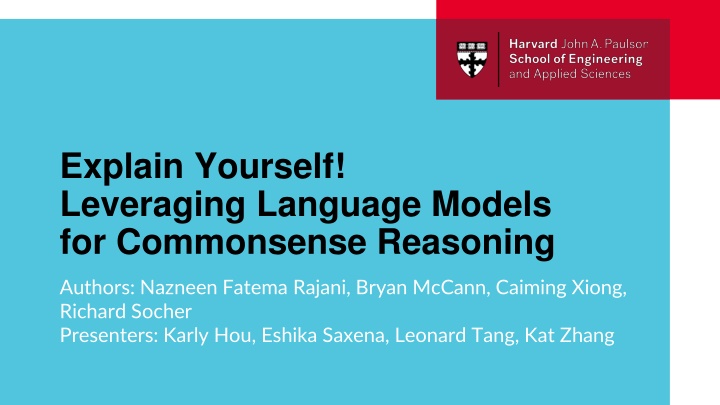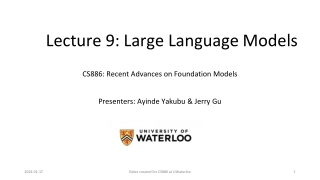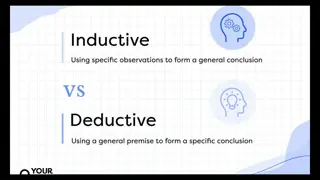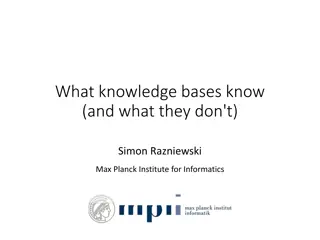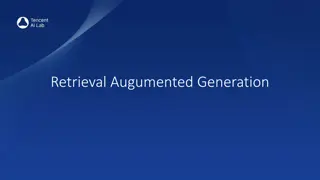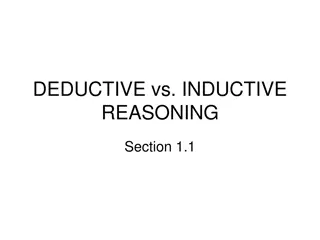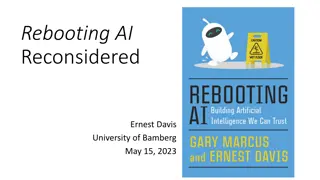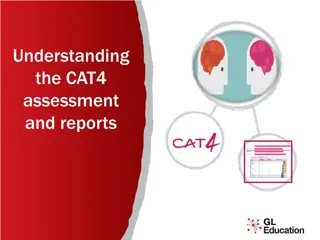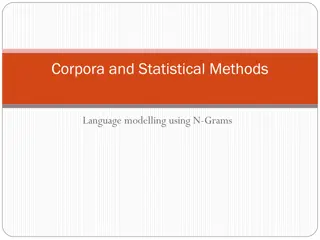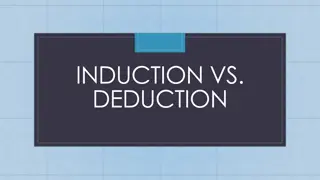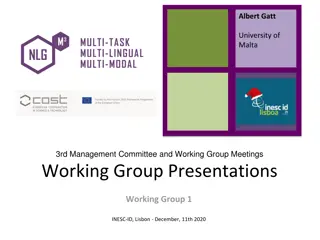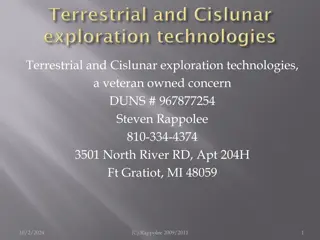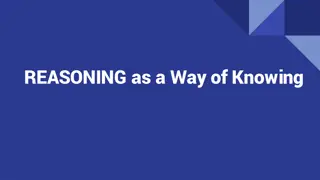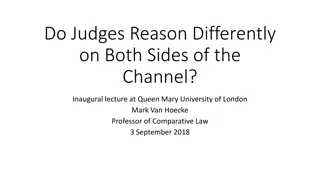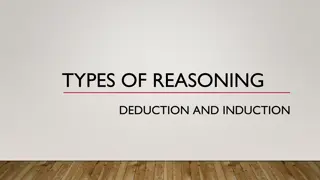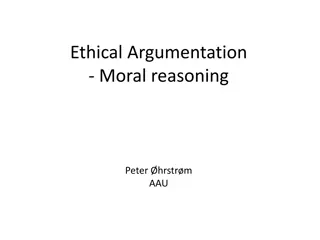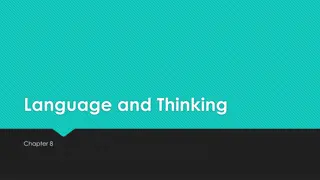Leveraging Language Models for Commonsense Reasoning Exploration
This study delves into commonsense reasoning using language models, highlighting challenges faced by modern ML methods and the role of explanations in enhancing model reasoning abilities. The research introduces Common Sense Explanations and Commonsense Auto-Generated Explanations, showcasing improvements in performance and explanation transfer across datasets. Additionally, related works on commonsense reasoning and natural language explanations are discussed, shedding light on interpretability and performance trade-offs. The study raises questions on the effectiveness of explanations in improving model performance.
Download Presentation

Please find below an Image/Link to download the presentation.
The content on the website is provided AS IS for your information and personal use only. It may not be sold, licensed, or shared on other websites without obtaining consent from the author.If you encounter any issues during the download, it is possible that the publisher has removed the file from their server.
You are allowed to download the files provided on this website for personal or commercial use, subject to the condition that they are used lawfully. All files are the property of their respective owners.
The content on the website is provided AS IS for your information and personal use only. It may not be sold, licensed, or shared on other websites without obtaining consent from the author.
E N D
Presentation Transcript
Explain Yourself! Leveraging Language Models for Commonsense Reasoning Authors: Nazneen Fatema Rajani, Bryan McCann, Caiming Xiong, Richard Socher Presenters: Karly Hou, Eshika Saxena, Leonard Tang, Kat Zhang
Introduction Commonsense reasoning: making human-like presumptions and judgements about ordinary situations Modern ML methods struggle with commonsense reasoning Explanations help verbalize reasoning that models learn while training Common sense Question Answering (CQA) dataset How do these models perform reasoning and to what extent is that reasoning based on world knowledge?
Key Contributions Common Sense Explanations (CoS-E): Collected human explanations (annotations and natural language explanations) to build on top of CQA
Key Contributions 1. Common Sense Explanations (CoS-E) 2. Commonsense Auto-Generated Explanations (CAGE) 3. CAGE outperforms best baseline by 10% and produces explanations to justify its predictions 4. Explanation transfer on two out-of-domain datasets
Related Work: Commonsense reasoning Commonsense reasoning datasets: Story Cloze: predicting story ending from a set of plausible endings Situations with Adversarial Generations (SWAG): predicting next scene based on initial event Models achieve human-level performance on some datasets Models struggle with understanding how pronouns resolve between sentences and world knowledge CQA addresses this by requiring models to infer from the question Language models perform poorly compared to human participants on CQA Unclear: Do models actually do common-sense reasoning?
Related Work: Natural language explanations Rationale generation by highlighting complete phrases in input text that are sufficient to predict desired output (Lei et al., 2016) Human-generated natural language explanations to train a semantic parser to generate noisy labeled data and train a classifier for generating explanations (Hancock et al., 2018) Interpretability comes at the cost of loss in performance on Stanford Natural Language Inference dataset (Camburu et al., 2018) Multi-modal: Ensemble explanations and visual explanations improve performance (Rajani and Mooney, 2018 and 2017) Do explanations for CQA lead to improved performance?
Related Work: Knowledge transfer in NLP Reliance on transfer of knowledge through pre-trained word vectors (e.g. Word2vec, GloVe) and contextualized word vectors (more refined with general encoding) Language models trained from scratch on large amounts of data and fine- tuned on specific tasks perform well Only a few parameters need to be learned from scratch Perform well on small amounts of supervised data Gap: Fine-tuned language models don t perform as well on CQA Can we leverage these models to generate explanations and show that these explanations capture common sense?
Dataset Structure/Creation - - Based on the CQA dataset CoS-E provides natural-language explanations for the correct answer choice and highlights important words in the question Explanations generated using MTurk Goal: To show whether models are performing reasoning correctly - - CQA CoS-E
Dataset Considerations - CoS-E-selected refers to the highlighted words, CoS-E-open-ended refers to the explanations Quality control was performed on the annotations and explanations Even explanations that don t discuss the ground truth answer are useful - -
CAGE Phase 1 Commonsense Auto-Generated Explanations (CAGE) Phase 1: Provide CQA example alongside corresponding CoS-E explanation to a language model Train model to generate the CoS-E explanation
CAGE Phase 2 Commonsense Auto-Generated Explanations (CAGE) Phase 2: Use language models to generate explanations for each example in the training and validation sets of CQA Provide CAGE explanations to a second model by concatenating it to the original input (question, answer choices, and language model output)
CAGE Phase 1: Intuition One training step for CAGE
How is CAGE trained? - Language Model trained to generate explanations from question-answer choice pairs Use pretrained OpenAI GPT Fine-tuned on the CQA and CoS-E dataset combination Two possible settings: explain-then-predict (reasoning) and predict-then-explain (rationalization) - - -
CAGE Notation - - - - - Question Answer choices Correct answer CoS-E explanation CAGE predict explanation
Reasoning - Model is fine-tuned on the question, answer choices, and explanation tokens, but not the actual label. - Objective Function (canonical conditional language modeling objective):
Rationalization - Model is now also given the ground truth label a: - Objective Function is the same as before but is also conditioned on the label a Thus, the explanations create rationalization that makes the model more interpretable -
Training Parameters - - - Generate sequences of maximum length 20 Batch Size: 36, Epochs: 10 Selected the best model using BLEU and perplexity scores
CAGE Inference Given human explanation from CoS-E or LM reasoning, can then perform predictions on CQA Simply concatenate Question, [Sep], Explanation, [Sep], Answer Choice as input to downstream CSRM (classifier) Use binary classification head on top of BERT backbone 3 answer choices 3 input sequences Take sequence yielding highest confidence as output
CSRM (BERT) Training HP Train batch size: 24 Test batch size: 12 10 training epochs Max sequence length of 50 for labels-only; 175 including explanations
Experimental Results Experimental Results
Experimental Results Experimental Results Google search question + answer choice for each example and collected 100 top snippets per answer as context for Reading Comprehension model Extra data did not improve accuracy CAGE-reasoning resulted in 10% accuracy gain over previous SOTA
Experimental Results Experimental Results Oracle upper-bound: human- generated explanations from CoS- E provided during training and validation Unfair setting bc human that provided explanation had ground truth answer CoS-E selected : explanation consists of words humans selected as justification for model
Transferring Explanations Across Domains Transferring Explanations Across Domains How well do natural language explanations transfer from CQA to SWAG and Story Cloze Test? Use GPT CAGE model fine-tuned on CQA train/dev to generate explanations on SWAG and Story Cloze Spring 2016 train/val Rinse and repeat using BERT with classifier head
Experimental Results Experimental Results Camburu et al (2018) show that transferring explanations from SNLI to MultiNLI performs very poorly Transfer of explanations on commonsense reasoning tasks NLI problem has small fixed set of pre- defined labels unlike commonsense reasoning tasks like CQA, SWAG, Story Cloze Adding explanations led to very small decrease in performance
Analysis of CAGE Analysis of CAGE CAGE-reasoning at train + validation 72% accuracy CoS-E-open-ended performance at 90% why the gap? Measure quality of CAGE Human evaluation (42% CAGE vs 52% CoS-E-open-ended) BLEU score measures syntactical precision by n-gram overlap Perplexity: token-level measure of how well language models predict next word Result: beneficial to fine-tune the LM, but humans and LMs have widely varying ways of providing useful explanations
Analysis of baseline BERT model Analysis of baseline BERT model Error analysis on baseline BERT w/o explanations: performs poorly on longer / more compositional questions explanations help w this CAGE reasoning typically simpler construction than CoS-E-open-ended, but adds meaningful context However, CAGE still provides incorrect answers often
Domain transfer: SWAG + Story Cloze Domain transfer: SWAG + Story Cloze
Conclusion CoS-E on top of CommonsenseQA CAGE framework LM leverages explanations Classifier on top of explanations SOTA performance on a difficult commonsense reasoning task Opens further avenues for studying explanation as it relates to interpretable commonsense reasoning
Discussion questions BLEU and perplexity as measures of goodness? Has been shown multiple times to correlate poorly with human judgement Joint training of explanation and label? Not one prior to other Can commonsense reasoning help general reasoning (e.g. mathematics, Fermi, counterfactual) in other domains? How to align human/machine explanations? Research merit of this work? Recent work (RLPrompt, AutoPrompt) has shown that optimal prompts for LMs (with respect to downstream task performance) are often times gibberish What does this say about the validity of using SOTA LMs for explanations? Can we regularize LM training to better align with human reasoning?
